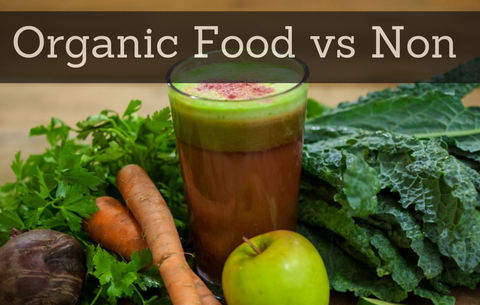
Health tops the list of concerns about GMOs, junk foods and food from factory farms. But consumers aren’t just rejecting these foods because of their potential to cause health problems. They’re consciously choosing organic for its nutritional superiority.
The health safety benefits of organic foods are well known. For the most part, organic farming prohibits the use of toxic pesticides, antibiotics, growth hormones, nanoparticles, climate-destabilizing chemical fertilizers like toxic sewage sludge or coal waste, and genetically engineered ingredients.
But recent studies reveal that organic foods, especially raw or non-processed, are also substantially more nutritious. They contain higher levels of beta-carotene, vitamins C, D, and E, health-promoting polyphenols, cancer-fighting antioxidants, flavonoids that help ward off heart disease, essential fatty acids, essential minerals, and significantly lower levels of saturated fats.
A Nutritional Comparison: Organic Versus Non-Organic
Organically grown apples, potatoes, pears, wheat, and sweet corn have drastically higher nutritional content than their conventionally grown counterparts, including:
63: Percent more calcium.
78: Percent more chromium.
73: Percent more iron.
118: Percent more magnesium.
178: Percent more molybdenum.
91: Percent more phosphorus.
125: Percent more potassium.
60: Percent more zinc.
Between 20 and 40: Additional percentage of nutrients found in organic wheat, tomatoes, potatoes, cabbage, onions, and lettuce compared with their conventional counterparts.
40: Additional percentage of antioxidants contained in organic fruit and vegetables compared with non-organic.
30: Percentage increase in levels of flavonoids contained in organic vegetables compared with conventionally grown produce.
25: Average percentage of organic foods are more nutritious in terms of vitamins and minerals than products derived from industrial agriculture.
55: Additional percentage of vitamin C contained in organic tomatoes at the stage of commercial maturity, compared with conventional tomatoes.
79 and 97: Percentage increase in levels of quercetin and kaempferol, both flavonoids, in organic tomatoes compared with conventional tomatoes. A 10-year study published in the Journal of Agricultural and Food Chemistry compared organic tomatoes with standard produce and found that organic tomatoes had almost double the number of antioxidants.
139: Additional percentage of phenolic content (associated with reduced risk of cardiovascular and degenerative diseases, and some forms of cancer) contained in organic tomatoes at the stage of commercial maturity, compared with conventional tomatoes.
57: Additional percentage of lycopene (considered a potential agent for prevention of some types of cancers, particularly prostate cancer) contained in organic ketchup with conventional national brands.
50: Percentage increase in levels of antioxidants in organic ketchup compared with conventional major national brands.
30: Average percentage increase in levels of resveratrol (antioxidant linked to reducing the risk of cancer, Alzheimer’s, diabetes, and heart disease) found in organic red grapes compared with conventionally grown red grapes.
49: Average percentage of whole food ingredients contained in organic breads, versus 24 percent in “natural” bread and only 12 percent in conventional bread. Preservative/Additive ingredients made up 27 percent of conventional bread ingredients versus only 10 percent and 7 percent in “natural” and organic bread, respectively.
40: Percentage increase in levels of some nutrients (including vitamin C, zinc and iron) found in organic produce compared with conventional produce.
58: Percentage increase of polyphenols (antioxidants that help prevent cardiovascular disease) in organically grown berries and corn compared with conventionally grown berries and corn.
52: Percentage increase in levels of vitamin C in organically grown berries and corn compared with conventionally grown berries and corn.
8.5: Percentage increase in total antioxidant activity in organic strawberries compared with conventional berries, including 9.7% more ascorbic acid, and 10.5% more total phenolics.
10 Times: The amount of eriocitrin (an antioxidant) contained in a glass of organic lemonade compared with a glass of its conventional counterpart.
3 times: The amount the flavonoid eriocitrin contained in organic lime juice compared with conventional lime juice.
Sources:
State of Science Review: Elevating Antioxidant Levels in …
EU-funded Quality Low Input Food Project Indicates Signif…
Fruit and Soil Quality of Organic and Conventional Strawb…
The Impact of Organic Farming on Quality of Tomatoes Is A…
Ten-Year Comparison of the Influence of Organic and Conve…
A Metabolomic Approach Differentiates between Conventiona…
State of Science Review: Nutritional Superiority of Organ…
Organic Farming, Food Quality and Human Health, The Soil …
State of Science Review: New Evidence Confirms the Nutrit…
A Comparison of Carotenoid Content and Total Antioxidant ...
Organic Foods Contain Higher Levels of Certain Nutrients…
Grains: An In-Depth Study, The Organic Center
Organic Fruit and Vegetables Really Are Better for Your H…
Organic Food is More Nutritious than Conventional Food, J…
First Step: Organic Food and a Healthier Future, The Orga…
J.A. Yanez et al., “Pharmacokinetics of Selected Chiral Flavonoids: Hesperetin, Naringenin, and Eriodictyol in Rats and their Content in Fruit Juices,” Biopharmaceutics Drug Disposition, Vol. 29, pp. 63-82, September 2007
Compiled by Zack Kaldveer, assistant media director for the Organic Consumers Association.

